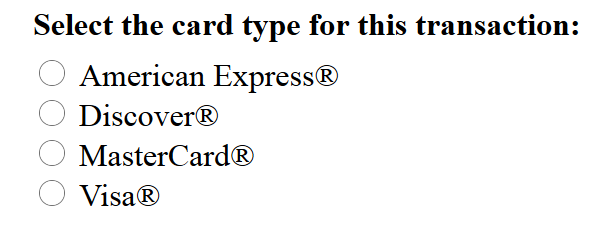Recently I blogged about three nice new Private PAIR features — USPTO nice again — this time letting you check customer numbers and Now you can update entity size yourself! and Get your own new USPTO customer numbers. Here is a fourth nice new Private PAIR feature. You can update the customer number associated with a patent application or patent yourself. Continue reading “Do your own patent application customer number changes!”
Get your own new USPTO customer numbers
Last week I blogged about two new Private PAIR features — USPTO nice again — this time letting you check customer numbers and Now you can update entity size yourself! Here’s another nice new Private PAIR feature just released by USPTO — you can obtain a new customer number with just a few mouse clicks. Continue reading “Get your own new USPTO customer numbers”
USPTO should not require “credit card type”
Every one of USPTO’s e-commerce systems — EFS-Web, TEAS, RAM, ETAS, and others — has a plac e where the system forces the user to answer this question.
e where the system forces the user to answer this question.
Continue reading “USPTO should not require “credit card type””
US PCT filers can soon pick Japan as ISA and IPEA
(Note the follow-up posting that this ISA choice is now available to US filers.)
Filers of PCT applications who file in RO/US will soon have the option to pick the Japanese Patent Office as their International Searching Authority and International Preliminary Examining Authority. Continue reading “US PCT filers can soon pick Japan as ISA and IPEA”
Intellectual property in “Silicon Valley”
The HBO television series Silicon Valley is now in its second season. I blogged about intellectual property issues in this series during its first season. The series is, of course, a work of fiction but its second season offers food for thought on patent issues and trademark issues. Continue reading “Intellectual property in “Silicon Valley””
USPTO nice again — this time letting you check customer numbers
The other day I blogged about a nice enhancement recently provided by USPTO — see “Now you can update entity size yourself!” At the same time, USPTO added a second nice enhancement. You can now independently check whether USPTO made mistakes with any of the three Customer Number fields in its databases. Continue reading “USPTO nice again — this time letting you check customer numbers”
Using NFC to make it easy for a visitor to use the guest wifi
In our office we have two wifi networks — a secure network that is available only for employee use, and a public network for visitors. (Actually it’s three wifi networks — a 5-GHz secure network, 2.4-GHz secure network, and a 2.4-GHz guest network.) When a visitor arrives, the usual first step is to get their smart phone or tablet or notebook computer connected to the guest network. The old-fashioned way is, of course, to give the visitor a piece of paper with the system ID and password, and they hand-key this information into their device.
But there are nice new ways to do this. Continue reading “Using NFC to make it easy for a visitor to use the guest wifi”
Now you can update entity size yourself!
USPTO did a good thing over the weekend. USPTO added a feature to Private PAIR that lets you change the entity size for a patent application yourself.
“Make America Great Again!” trademarked by Donald Trump?
(Trump files three more trademark applications: followup blog post here.)
It turns out that Donald Trump filed a US trademark application in 2012 for the mark “Make America Great Again”. In May of this year he filed a Statement of Use and barring some surprise, the USPTO will soon grant a trademark registration.
The identified services are “political action committee services, namely, promoting public awareness of political issues” and “fundraising in the field of politics”.
How to correct a check-the-box mistake?
We are familiar with the “check-the-box” problem. The AIA provides that for a “transition” application, the law to be applied to determine what is patentable and what is not patentable is based on whether the application contains, or ever contained, at least one claim the effective filing date of which is on or after March 16, 2013. (A “transition” application is an application filed on or after March 16, 2013 that claims domestic benefit or foreign priority from an application filed prior to March 16, 2013.) The AIA did not say who exactly is supposed to figure out whether such a claim exists or existed. Unfortunately for applicants, in the February 14, 2013 Final Rules the USPTO successfully shifted this claim analysis burden to the applicant (more accurately, to the patent practitioner).  It falls to the practitioner to work out whether or not this box should be checked. And years later in litigation of such a transition application, it will often happen that an accused infringer will devote enormous amounts of time and energy exploring whether a case can be made the the practitioner made a check-the-box mistake — checking the box when it should not have been checked, or failing to check the box when it should have been checked.
It falls to the practitioner to work out whether or not this box should be checked. And years later in litigation of such a transition application, it will often happen that an accused infringer will devote enormous amounts of time and energy exploring whether a case can be made the the practitioner made a check-the-box mistake — checking the box when it should not have been checked, or failing to check the box when it should have been checked.
Which gets us to the topic of this blog posting. What if, during the pendency of a transition application, the practitioner discovers to his or her horror that a check-the-box mistake was made? Can the mistake be corrected? If so, how? Continue reading “How to correct a check-the-box mistake?”
